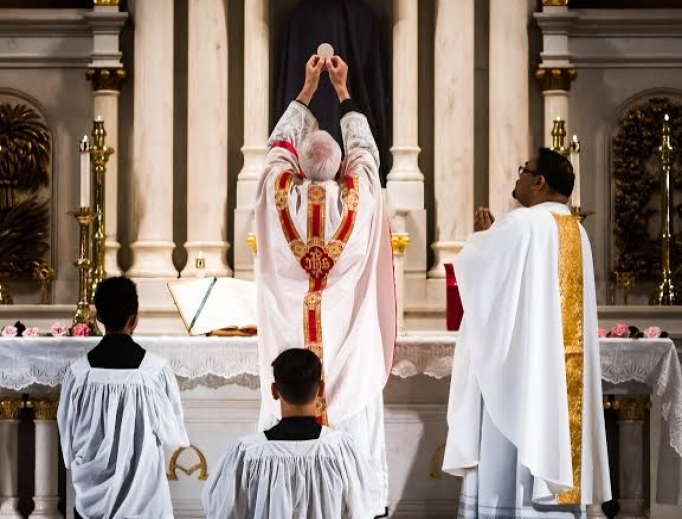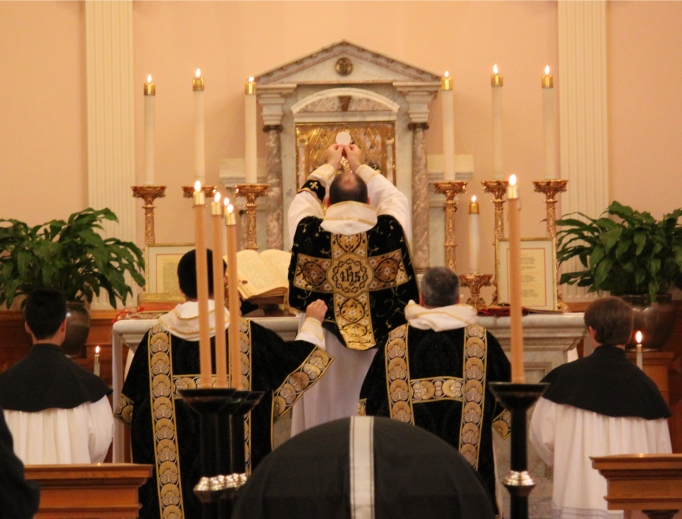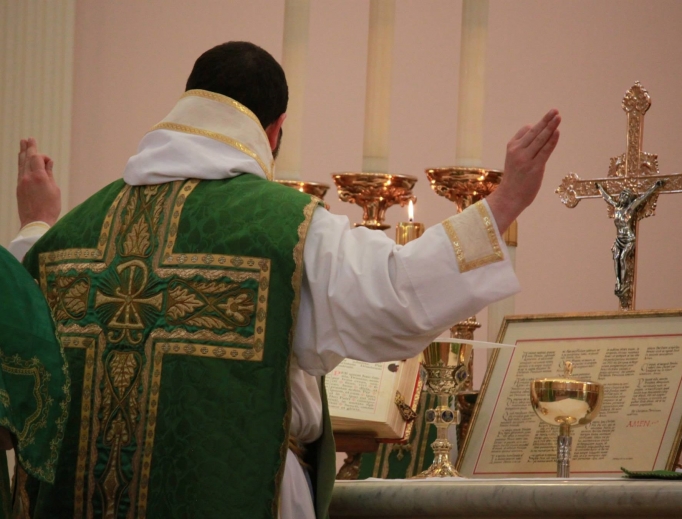Ad Orientem Posture Given New Life in Nebraska
Cardinal Robert Sarah, the prefect of the Congregation for Divine Worship, has provided the latest inspiration for its use in the ordinary form of the Mass.

WAHOO, Neb. — Sudden changes in the life of a parish come rarely. But on the first weekend in October, at St. Wenceslaus in Wahoo, Nebraska, Father Joseph Faulkner announced an unexpected decision on the liturgy: The parish would celebrate Mass ad orientem — both the priest and the people facing the altar in the same direction — for a year.
St. Wenceslaus joins a slow stream of parishes that are experiencing liturgical renewal through returning to the ad orientem (facing the east) position in the celebration of the ordinary form of the Mass. While the movement has gained ground slowly, many priests credit last year’s remarks from Cardinal Robert Sarah with jump-starting further interest in it.
At the 2016 Sacra Liturgia conference in London, Cardinal Sarah, the prefect of the Congregation for Divine Worship and the Discipline of the Sacraments, asked priests to face ad orientem when saying Mass, as a means to ensure that “in our celebrations the Lord is truly at the center.” While the Vatican quickly issued a statement that “new liturgical directives are not expected,” and emphasized the unofficial nature of Cardinal Sarah’s remarks, many priests were inspired by his words.
Father Faulkner, the pastor of St. Wenceslaus, told the Register that his parish is the largest in the diocese so far — at 700 families — to implement ad orientem.
“There’s no place you can’t do it,” he said, if ad orientem can be introduced at a parish his size.
Ad orientem, which means “to the east,” refers to the practice literally of saying Mass facing the East, but has also come to refer to the priest and people facing the same direction during some parts of the Mass. Cardinal Sarah wrote in L’Osservatore Romano that “the penitential rite, the singing of the Gloria, the orations and the Eucharistic Prayer” could all be occasions when priest and faithful face East together, while some priests who have adopted the ad orientem posture do so only during the Eucharistic Prayer.
Father Faulkner was not always a supporter of the ad orientem posture. He “intensely” resisted the idea of Mass ad orientem during his time in seminary, and only gradually came to accept the arguments for it.
Among the arguments made by proponents of celebrating Mass ad orientem is the unity of the community in awaiting the coming of the Lord and the visible sign it gives of the whole parish community addressing God.
While he acknowledges that he will miss some aspects of celebrating Mass versus populum (facing the people), Father Faulkner believes it will be better for the prayer and worship of his community.
He has asked his parish to undertake celebrating Mass ad orientem as a “spiritual exercise” for a year.
“We’re giving it a shot. We’re trying it for a year and then will re-evaluate,” he said.
Discovering Ad Orientem
Even if their parishes don’t celebrate ad orientem on a full-time basis, the Diocese of Lincoln has a significant number of priests who use it at least during Advent. Much of that is due to the example of Bishop James Conley, who in 2014 decided all Sunday Masses at the cathedral during Advent would be celebrated ad orientem. The practice has been renewed every year since, and priests in the diocese have been given permission to institute ad orientem worship in their parishes, provided there has been appropriate preparation.
Father Karl Millis, of St. Joseph’s in Auburn, Nebraska, told the Register that when his parish switched to saying Mass only ad orientem a year ago, he went through a learning experience along with his parishioners. He said ad orientem worship brings a physical clarity to the liturgy, showing that when the priest addresses God the Father, he faces him, and when he speaks to the people, he faces them.
Father Millis said that for him and for other parishioners, praying ad orientem has allowed for deeper reverence and understanding of their prayers.
Father Steven Thomlison, at St. Stephen’s in Exeter, Nebraska, echoed other priests when he told the Register that while initial reactions in the parish ranged from skeptical to intrigued, there has been a widespread embrace of celebrating ad orientem in the three years since he introduced the parish to the practice.
“It’s wonderful to celebrate Mass oriented toward Our Lord,” he said.
Harvest of Vatican II
The slow return of interest in ad orientem worship finds a mirror image in its precipitous decline after the Second Vatican Council. Christopher Ruddy, associate theology professor at The Catholic University of America, told the Register that the Council documents never mentioned an end to ad orientem celebration of the Mass.
Instead, the Vatican issued a liturgical instruction after the Council, which stated, “The main altar should preferably be freestanding, to permit walking around it, and celebration facing the people.”
Ruddy said that there was a Vatican and papal impetus behind versus populum, which did not mandate it, but permitted and encouraged it.
“It’s sort of striking how readily this change was accepted by the vast majority of Catholics,” he said.
Father Joseph Illo, who in the past year introduced ad orientem worship to Star of the Sea parish in San Francisco, California, told the Register he did not think this kind of change would have been possible a decade ago.

While Cardinal Sarah’s remarks were the immediate inspiration for him to ask permission of the archdiocese to try ad orientem, the work of Benedict XVI had articulated clearly the reason and direction of the liturgical renewal envisioned by Vatican II. His principles had been popularized and spread through the Church, so that people were prepared to do what Vatican II had asked, including a recognition of the importance of ad orientem worship.
Father Illo said the two poles of the Council were aggiornamento and ressourcement, “bringing up to date” and “return to the sources.” While aggiornamento had been predominant after the Council, “now we’re discovering the other axis of the Council and the reform, which is getting back to the sources,” he explained.
Oriented to the Cross
Dominican Father Vincent Kelber of Holy Rosary parish in Portland, Oregon, told the Register that ad orientem worship being a year-round part of the ordinary form has “brought a lot of focus, brought a lot of peace and brought a lot of prayer” to his parish community.


At the same time, he cautioned against letting a particular orientation distract the faithful from the presence of Christ in the liturgy. Citing Benedict XVI, Father Kelber said that no matter which way the celebration is oriented, all Masses have to be ad crucem, focused on the sacrifice on the cross.
“We need to emphasize that, so whatever form or whatever orientation we use, the better off we’ll be, and the more unified we’ll be.”
Register correspondent Nicholas Wolfram Smith writes from Oakland, California.

















